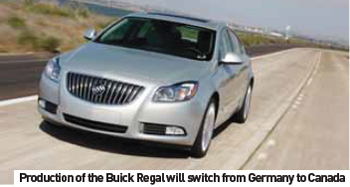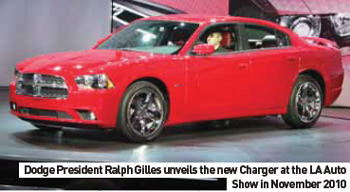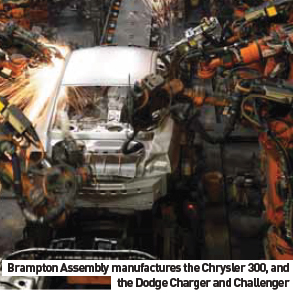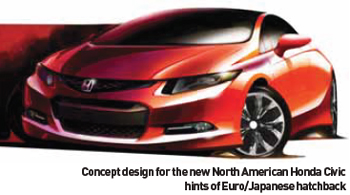
For a relatively small market, Canada punches way above its weight. The country’s annual vehicle sales may total only around one tenth of those of its southern neighbour, but the province of Ontario is home to many car and light truck plants, each of which has an enviable export programme.
Last year might not have started well for vehicle and powertrain manufacturing plants in Ontario, but as the US and Canadian economies began to haltingly expand, so too did production. The shuttering in March last year of NUMMI, the former Toyota and General Motors plant in San Francisco, greatly helped matters - Toyota’s facility at Cambridge, Ontario was flexible enough to step in and produce the required Corolla and Matrix models needed for the US market.
As 2010 drew to a close, the Canadian new vehicle market was firmly back in growth mode, posting a 1.4% year-onyear rise in October, accelerating to 13.6% (to 115,981 light vehicles) in November. Light vehicle sales in Canada were up 7.1% (1,445,460 units) for the first eleven months of 2010, compared to 1,349,395 vehicles sold over the same period in 2009.
Interestingly, November’s sales increase was underwritten by the light truck segment, which expanded 26.6% yearon- year, according to figures compiled by DesRosiers Automotive Consultants (DAC), the Association of International Automobile Manufacturers of Canada (AIAMC), and the Canadian Vehicle Manufacturers’ Association (CVMA).
In fact, the popularity of light trucks in Canada, as is the case in the US, has continued to exceed that of passenger vehicles. In November 2010, a total of 64,986 light trucks was sold, while passenger car sales were 50,995 units, a mere 0.4% more than what the segment had achieved in November 2009. GM, Ford and Chrysler, each of which has manufacturing operations in Ontario, saw their combined sales rise by 27% from a year earlier, to 53,696 units.
In addition to the big pickups, full-size minivans, compact SUVs, saloons and hatchbacks (and even some subcompact hatchbacks) continue to make up the majority of sales in this market. With the exception of the country’s second best selling vehicle, the Mazda3, virtually all of the most popular models are built in North America. Two other imports, the Honda Fit (built in Sayama, Japan) and the BMW 3 Series (Munich, Germany) each made it into the top-ten as the year came to a close.
After the collapse of 2009 sales, General Motors of Canada (GMCL) has recently started to claw back sufficient market share to challenge Ford, the most successful automaker of 2010. In November, GMCL’s four brands (Buick, Cadillac, Chevrolet and GMC) combined to lead the Canadian light vehicle market, selling 20,122 units (+34.5%), followed by Ford, which managed 18,375 units (+15.6%).
Although it was deposed by GM, Ford still enjoyed its best November in nine years, thanks largely to the F-Series pickup, Escape SUV and Focus saloon. With regards to trucks, Ford ranks well above all-comers, the F-Series selling 185,801 units over the first eleven months of 2010; the Dodge Ram took second spot with 126,174 sales.
Like GM and Ford, Chrysler Group has also enjoyed a welcome reversal of fortune after the negative publicity generated by various plant closures. The recapitalization of the Michigan-based company was partly undertaken by the Canadian government, with Ottawa’s support further backed by the provincial authorities of Ontario in Toronto. The Canadian Auto Workers’ Union (CAW) also played a major role in saving two threatened plants, and remains a significant shareholder in the new Chrysler Group LLC.
Once the largest vehicle manufacturing facilities on the North American continent, General Motors’ Oshawa plant, located near Toronto, is now a shadow of its former self. As the price of petrol skyrocketed in mid-2008, closely followed by a steep decline in the overall US economy, the decision was made to halt production of the Chevrolet Silverado and GMC Sierra full-size pickups at the former GMCL Oshawa Truck plant. Ironically, the then recently-introduced, fuelefficient hybrid variants of the Silverado and Sierra twins were also axed in the move. Today, vast parts of the giant Oshawa site lie idle, as GM manufacturing operations in Mexico and the US have taken over production of these models.
 Part and parcel of the US and Canadian governments’ decision to push General Motors into bankruptcy was the need to face the reality of excess manufacturing capacity in both countries. After a series of strikes, even the CAW eventually agreed that the cuts were necessary if Oshawa were to survive at all. In a case of all’s well that ends well, GMCL (which is also headquartered at Oshawa), is now ramping up production and adding new models on its new flexible manufacturing lines. Only recently, some 700 workers were recalled for a second shift in preparation for the launches of the Chevrolet Camaro convertible and the Buick Regal.
Part and parcel of the US and Canadian governments’ decision to push General Motors into bankruptcy was the need to face the reality of excess manufacturing capacity in both countries. After a series of strikes, even the CAW eventually agreed that the cuts were necessary if Oshawa were to survive at all. In a case of all’s well that ends well, GMCL (which is also headquartered at Oshawa), is now ramping up production and adding new models on its new flexible manufacturing lines. Only recently, some 700 workers were recalled for a second shift in preparation for the launches of the Chevrolet Camaro convertible and the Buick Regal.
The new models will be built alongside the existing Camaro coupe. Production of the Camaro convertible commenced in January, with the Regal to follow from March.
With the start of Buick Regal production in Canada, the GM Europe (Opel) plant in Rüsselsheim, Germany, will no longer be supplying the car for North America - the Regal is essentially a rebadged and homologated Opel Insignia.
The launch of the 2011 Buick Regal follows the start of a third shift at the Oshawa plant’s Consolidated Line last October. This enabled a much-needed rise in production for the Chevrolet Equinox, a popular model in the US. Together, the two new shifts have secured more than 1,300 jobs. In addition to having now recalled all formerly laid-off production workers, GM Canada further notes that it has taken on over 300 new employees.
 “With three new vehicle launches underway and the addition of two new shifts, the Oshawa Assembly Plant has become a model for flexibility,” says Kevin Williams, President and Managing Director of GMCL. “Through a disciplined approach and a relentless focus on execution, the Oshawa team has worked efficiently to implement these significant initiatives.”
“With three new vehicle launches underway and the addition of two new shifts, the Oshawa Assembly Plant has become a model for flexibility,” says Kevin Williams, President and Managing Director of GMCL. “Through a disciplined approach and a relentless focus on execution, the Oshawa team has worked efficiently to implement these significant initiatives.”
Future products for Oshawa are believed to include a single-model replacement for the outgoing Cadillac DTS and STS saloons, as well as the next-generation Chevrolet Impala. The Cadillac XTS should start running down the line at Oshawa from late 2011. A closely-related, longwheelbase variant (‘XLS’) for China should follow at Shanghai GM’s Pudong plant in 2012.
The same front- and all-wheel drive Epsilon 2 platform that underpins the Buick Regal is likely to be the basis for the Cadillac XTS and XLS. The Chevrolet Impala replacement (GMX 551) should also sit on Epsilon 2; production of the big car for North America is expected to start in time for the 2013 model year.
GMCL Oshawa and CAMI: flexible manufacturing
GMCL has a further plant in Ontario, a former joint-venture with Suzuki which is now a GM-only operation. Called CAMI, the facility is located 125 miles away in Ingersoll and, like Oshawa, is organized by the Canadian Auto Workers (CAW).
In recent times, CAMI has been notable for an innovative set of practices agreed to by both GMCL and the CAW.
These flexible manufacturing arrangements have addressed problems surrounding increased supply of two Ingersollbuilt crossovers, the Chevrolet Equinox and GMC Terrain.
The solution agreed to by the union was simple, allowing assembly of the models at Oshawa on the new, so-called ‘Consolidated’ line. The Ingersoll plant was running on three shifts, as well as three Saturdays per month during much of 2010, and continues to be one of GM’s most recent and strongest success stories in North America.
As for the vehicles themselves, Terrain production at CAMI started in August 2009, Suzuki halting production of its XL-7 model to make way for this compact crossover. The Equinox, a larger SUV, was rebodied for North America’s 2010 model year in June 2009, with an all-new replacement due in 2014. The next Terrain could be launched as soon as 2012, with both vehicles using GM’s front- and all-wheel drive Theta architecture.
 The last twelve months have been memorably positive for Ford’s Canadian operations. The second-generation Focus, an import from the Wayne, Michigan plant, remained popular over its last year of production, as did the Escape compact SUV and F-Series range. The locally-built Ford Edge and Lincoln MKX crossovers also performed well, the twin models built alongside each other at the company’s Oakville plant, near Toronto. “The industry continues to lean heavily towards truck sales, but as fuel prices rise, the market will adjust,” says Ford of Canada President and CEO, David Mondragon. Following on from that, it is perhaps ironic that Ford of Canada continues to build some of the OEM’s largest petrol engines, the V8 and V10 engines featuring in some of the group’s light- and heavy-duty pickups and SUVs.
The last twelve months have been memorably positive for Ford’s Canadian operations. The second-generation Focus, an import from the Wayne, Michigan plant, remained popular over its last year of production, as did the Escape compact SUV and F-Series range. The locally-built Ford Edge and Lincoln MKX crossovers also performed well, the twin models built alongside each other at the company’s Oakville plant, near Toronto. “The industry continues to lean heavily towards truck sales, but as fuel prices rise, the market will adjust,” says Ford of Canada President and CEO, David Mondragon. Following on from that, it is perhaps ironic that Ford of Canada continues to build some of the OEM’s largest petrol engines, the V8 and V10 engines featuring in some of the group’s light- and heavy-duty pickups and SUVs.
Despite being the top player in an expanding local market, Ford has stated its future intention is to reduce current manufacturing capacity. This will come via the shuttering of the 42-year old St Thomas plant in September. The facility, near London, Ontario, has recently ended production of the Mercury Grand Marquis, one of the three large, rear-wheel drive saloons that have been produced there for many years.
The other two St Thomas-built models are more or less the same vehicle as the Grand Marquis – the Ford Crown Victoria and Lincoln Town Car. Using the now out-dated Panther platform, a body-on-frame design which dates back to 1979, there will be no direct replacements for these cars.
As the Town Car has been a popular limousine model across North America for some thirteen years now, Ford is hoping that two modified versions of the Lincoln MKT will serve as fitting replacements for the livery market. The non-limo version of this big crossover is already made at the Oakville plant.
Ford is not due to replace the MKT and its Ford Flex twin until 2015, though neither of these big front- and all-wheel drive models has been more than a moderate success to date.
The smaller Ford Edge and Lincoln MKX, both based on the first-generation Mazda6 platform, are due to be phased out in 2013. Ford is yet to confirm the build location of the successors for these models, or indeed what new, upcoming models will be built by Ford of Canada.
“We are on the home stretch of a very good year. Production at our Canadian plants is up 76%, sales are up 28%, and we have 14 new products starting to launch,” stated Reid Bigland, President and Chief Executive of Chrysler Canada towards the end of last year. Indeed, November was Chrysler Group LLC’s 12th consecutive month of sales growth, with sales up by 33.1% to 15,199 units during the month.
Much of Chrysler’s success stems from the brave decisions taken in 2008 and 2009 to invest heavily in new products for its two Ontario plants. These facilities, each located just across the border from its Michigan headquarters, can be broadly thought of as dedicated to respectively delivering full-sized, front-wheel drive minivans (Windsor) and large rear- or all-wheel drive saloons (Brampton).
Chrysler has been the traditional minivan segment leader in the US market, with its Dodge Grand Caravan and Chrysler Town & Country twins. Production of the current RT platform models commenced at Windsor in 2008, which was followed by the introduction of heavily updated 2011 versions of both from December 2010. The 2011 T&C will be the test model for a new strategy, which will see Chrysler vehicles pitched as luxury alternatives to the equivalent Dodge models, particularly in the US market.
 The Windsor plant, which is now back to three-shift operation, also produces the Volkswagen Routan, a restyled Town & Country/Grand Caravan that is only sold in North America. Largely unloved, even the most positive-minded marketing personnel would hesitate to call this model a success, meaning it might already be living on borrowed time. A similar fate may await yet another model that could still enter contract production at Brampton, the proposed replacement for the Lancia Phedra. Due for launch across continental European markets in late 2011, it is not entirely clear why Fiat Group believes a rebadged Town & Country/ Grand Voyager will prove successful for Lancia, when the segment itself is in steep decline across most European markets.
The Windsor plant, which is now back to three-shift operation, also produces the Volkswagen Routan, a restyled Town & Country/Grand Caravan that is only sold in North America. Largely unloved, even the most positive-minded marketing personnel would hesitate to call this model a success, meaning it might already be living on borrowed time. A similar fate may await yet another model that could still enter contract production at Brampton, the proposed replacement for the Lancia Phedra. Due for launch across continental European markets in late 2011, it is not entirely clear why Fiat Group believes a rebadged Town & Country/ Grand Voyager will prove successful for Lancia, when the segment itself is in steep decline across most European markets.
The RT-series front-wheel drive minivans built at Brampton were evolved from the previous RS-platform models that were manufactured between 2003 and 2008. Thus an all-new architecture can be expected for the RU models due for launch in 2014. Following on from this, logic predicts that Fiat Professional’s larger delivery vans would also shift onto this platform. Brampton may also be the source of build for a forthcoming Dodge Ram derivative of the next Fiat Ducato for the US, Canada and Mexico.
Chrysler’s Brampton operation builds every rear- and all-wheel drive saloon or coupe sold by the Group. This range of cars, the LX series, includes the 2011 Chrysler 300 saloon together with its twin, the 2011 Dodge Charger, both of which were launched at the LA Auto Show last November, with production kicking off in December.
Of particular interest with these rear-drive models is the replacement of the former 2.7- and 3.5-litre V6 engines by a single 3.6-litre Pentastar unit, fitted horizontally-opposed as with the Brampton-built minivans. The recently-facelifted (2011MY) Dodge Challenger, which is built on the same line at Windsor, has also been given the new V6 as its entry-level engine. Further demonstrating the flexibility of the unit, it also features in the new Sterling Heights, Michigan-built Chrysler 200 and Dodge Avenger saloons.
For all the expected success that the new 300 and Charger will no doubt enjoy, it’s worth mentioning that buyers in this segment are increasingly looking to four-cylinder engines, something that the next Ford Taurus and Chevrolet Impala are said to be switching to for entry-level versions.
Chrysler might not have a petrol four-cylinder/rear-wheel drive drivetrain, but it will be offering a diesel alternative for the Chrysler 300 and its Lancia-badged twin in European markets from late 2011. The group may eventually decide to make this engine available to US buyers should petrol prices increase again.
As for the future of Brampton, there is no planned replacement for the first-generation Chrysler 300 wagon (produced by Magna Steyr, the model was not offered in North America). In order to compete with the Chevy Camaro and Ford Mustang convertibles, a soft-top version of the Dodge Challenger is reportedly under development (any reduction in the four-year development of the Camaro version would be an improvement), while Chrysler may even elect to build a closely-related rear-wheel drive Alfa Romeo Spider at the plant from 2013.

Honda of Canada (HCM) was the first Japanese OEM to build cars in the country. Established in 1986, the Accord saloon was the first model to enter production. Today, the facilities near Alliston, Ontario, comprise two manufacturing plants making various vehicles. An adjacent powertrain plant manufactures up to 200,000 four-cylinder engines a year.
According to HCM, over CA$2.6bn ($2.57bn) has been invested at Alliston, which now has 4,000 employees. The Civic saloon, the best-selling car in Canada, is the main product, and is produced by both Plant 1 and 2. Other models include a rebadged Civic, the Acura CSX, which is exclusive to the local market, as well as the Civic Coupe and two crossovers for the upscale Acura division, the MDX and ZDX. Total annual capacity is 390,000 units.
 The 2.1 million sq. ft. complex includes all major production operations, including stamping, welding, paint and assembly. A second production shift for Plant 2 is set to recommence later in the first quarter of 2011, increasing output from 400 to 600 units per day. This, after output numbers were slashed in February 2009 due to declining vehicle sales in the US and Canada. “We are pleased to be making this announcement as the Canadian economy continues to show signs of recovery,” Manabu Nishimae, CEO of Honda Canada, stated in third quarter 2010.
The 2.1 million sq. ft. complex includes all major production operations, including stamping, welding, paint and assembly. A second production shift for Plant 2 is set to recommence later in the first quarter of 2011, increasing output from 400 to 600 units per day. This, after output numbers were slashed in February 2009 due to declining vehicle sales in the US and Canada. “We are pleased to be making this announcement as the Canadian economy continues to show signs of recovery,” Manabu Nishimae, CEO of Honda Canada, stated in third quarter 2010.
HCM will start making the ninth-generation Civic at Alliston in late 2011. This might also mean that the replacement for the Canada-only Acura CSX might be built for export: Acura management has told its US dealers that it is ‘considering’ a rival for the Audi A3. This wouldn’t necessarily dictate a five-door hatchback bodystyle, as the German carmaker is known to be planning an A3 saloon for launch in North America by 2012.
Toyota was the only high-volume OEM to post declining sales throughout much of last year. In November alone, Toyota’s Canadian sales fell by 25% year-on-year, to only 11,116 units. Such a downturn can be traced back to the recalls of the last two years and aggressive pricing strategies introduced by Hyundai and Kia.
While neither Korean brand has a Canadian manufacturing operation (a Hyundai plant at Bromont, Quebec, was shuttered in 1993 after only four highlytroubled years), rumours that the group is planning a fresh start – supposedly in Ontario – continue to surface from time to time. For now, both brands are aiming to build on the successes of 2010: Hyundai overtook Honda to become the sixth largest seller of light trucks from January to November last year, with Toyota only 276 units ahead of fifth-placed GMC.
 Toyota has already taken some steps to try and arrest this decline, which also extends to Lexus operations in Canada. The Scion brand, formerly available only in the US, has just been introduced at 46 dealerships in Toronto, Vancouver, and Montreal.
Toyota has already taken some steps to try and arrest this decline, which also extends to Lexus operations in Canada. The Scion brand, formerly available only in the US, has just been introduced at 46 dealerships in Toronto, Vancouver, and Montreal.
In terms of manufacturing operations, Toyota Canada (TCI) has a unique distinction – it is the only Lexus plant outside Japan. This facility, which makes the RX 350 crossover (the RX 450h hybrid is built exclusively in Japan) is located in the city of Cambridge. The larger and older of Toyota’s two Ontario plants, also manufactures the Corolla saloon and Matrix five-door hatchback, both of which are due for replacement in 2012.
Cambridge may still switch to another product once the company’s new plant in Blue Springs, Mississippi, starts manufacturing operations in late 2011. In June 2010, Toyota announced that the Corolla/Matrix assembly line from the NUMMI plant in California (ultimately sold to Tesla Motors in 2010) would be shifted to the Blue Springs plant. The second of TCI’s manufacturing facilities is in Woodstock and commenced operations in November 2008, just as vehicle sales began to plummet across North America.
The planned two-shift, 150,000-unit capacity for Woodstock was halved just before the facility began building the 120L RAV4, its sole product. In December 2009, plans for the second shift were announced, commencing in March 2010. As this SUV was already several years old when production started at Woodstock, the fourth-generation RAV4 (codenamed 120X) is likely to be built at the plant, starting in the second or third quarter of 2011.
There have been suggestions that a new, additional crossover for Lexus division will be the eventual third shift for Woodstock. This proposed ‘JX’ model, a direct rival for the Audi Q5, is reported to be on the way for 2012.
With the exception of Ford’s St Thomas plant, marked several years ago for closure in September 2011, each of the current five OEMs building vehicles in Ontario plan to steadily expand their existing operations in the short to medium term.
The province, where almost all Canadian vehicle and powertrain operations are located, remains the country’s hub for automotive knowledge and manufacturing skills. While the vehicle manufacturing sector is just beginning to re-emerge, somewhat buffeted by the winds of the ‘Great Recession’, it is clearly standing on solid ground and ready for the next phase of growth.




































